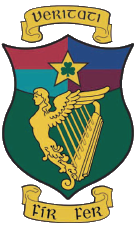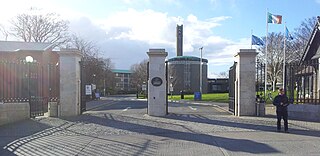
The National University of Ireland (NUI) is a federal university system of constituent universities and recognised colleges set up under the Irish Universities Act, 1908, and significantly amended by the Universities Act, 1997.

Eoin MacNeill was an Irish scholar, Irish language enthusiast, Gaelic revivalist, nationalist and politician who served as Minister for Education from 1922 to 1925, Ceann Comhairle of Dáil Éireann from 1921 to 1922, Minister for Industries 1919 to 1921 and Minister for Finance January 1919 to April 1919. He served as a Teachta Dála (TD) from 1918 to 1927. He was a Member of Parliament (MP) for Londonderry City from 1918 to 1922 and a Member of the Northern Ireland Parliament (MP) for Londonderry from 1921 to 1925.

St Patrick's College, often known as St Pat's, was a third level institution in Ireland, the leading function of which was as the country's largest primary teacher training college, which had at one time up to 2,000 students. Founded in Drumcondra, in the northern suburbs of Dublin, in 1875, with a Roman Catholic ethos, it offered a number of undergraduate courses, primarily in primary education and arts, and in time postgraduate courses too, mostly in education and languages.

All Hallows College was a college of higher education in Dublin. It was founded in 1842 and was run by the Vincentians from 1892 until 2016. On 23 May 2014, it was announced that it was closing because of declining student enrollment. The sale of the campus in Drumcondra to Dublin City University was announced on 19 June 2015 and completed on 8 April 2016. The college closed on 30 November 2016, becoming the All Hallows Campus of Dublin City University.

Drumcondra is a residential area and inner suburb on the Northside of Dublin, Ireland. It is administered by Dublin City Council. The River Tolka and the Royal Canal flow through the area.

The Royal Irish Academy, based in Dublin, is an academic body that promotes study in the sciences, humanities and social sciences. It is Ireland's premier learned society and one its leading cultural institutions. The Academy was established in 1785 and granted a royal charter in 1786. As of 2019 the RIA has around 600 members, regular members being Irish residents elected in recognition of their academic achievements, and Honorary Members similarly qualified but based abroad; a small number of members are elected in recognition of non-academic contributions to society.

Our Lady of Mercy College, Carysfort was a College of Education in Dublin, Ireland from its foundation in 1877 until its closure in 1988. Educating primary school teachers, and located in a parkland campus in Blackrock, it was a recognised college of the National University of Ireland from April 1975. The site is now the premises of the Michael Smurfit Graduate Business School, part of University College Dublin.

Gerald FitzMaurice FitzGerald (1335–1398), also known by the Irish Gaelic Gearóid Iarla, was the 3rd Earl of Desmond, in southwestern Ireland, under the first creation of that title, and a member of the Hiberno-Norman dynasty of the FitzGerald, or Geraldines. He was the son of Maurice FitzGerald, 1st Earl of Desmond, by his third wife Aveline (Eleanor), daughter of Nicholas FitzMaurice, 3rd Lord of Kerry. He was half-brother to Maurice FitzGerald, 2nd Earl of Desmond.

The Dominican Order has been present in Ireland since 1224 when the first foundation was established in Dublin, a monastic settlement north of the River Liffey, where the Four Courts is located today. This was quickly followed by Drogheda, Kilkenny (1225), Waterford (1226), Limerick (1227) and Cork (city) (1229). The order was reestablished in the 19th century after having been driven out in the 17th century by laws against Catholic religious orders. During the Penal Laws, as other Irish Colleges were established on the continent, in 1633 the Irish Dominicans established, the College of Corpo Santo, Lisbon and College of the Holy Cross, Louvain (1624-1797) to train clergy for ministering in Ireland. San Clemente al Laterano in Rome, was entrusted to the Irish Dominicans in 1677. In 1855, St. Mary's Priory, Tallaght, was established to train members of the order, who would complete their clerical studies in Rome and be ordained in the Basilica San Clemente.

Gearóid O'Sullivan was an Irish teacher, Irish language scholar, army officer, barrister and Sinn Féin and Fine Gael politician.
Mainchín mac Setnai, also anglicised to Munchin, was allegedly the founder of the church of Luimneach, Ireland, and a saint in Irish tradition, acquiring special eminence as patron of Limerick City. Both his origins and the date of his association with the city are debated.
Eoghan Ó Tuairisc was an Irish poet and writer.

The Book of Lismore, also known as the Book of Mac Carthaigh Riabhach, is a late fifteenth-century Gaelic manuscript that was created at Kilbrittain in County Cork, Ireland, for Fínghean Mac Carthaigh, Lord of Carbery (1478–1505). Defective at beginning and end, 198 leaves survive today, containing a miscellany of religious and secular texts written entirely in Irish.

St Patrick's blue is a name often mistakenly applied to several shades of blue associated with Ireland. The official colour of Ireland in heraldic terms is azure blue. The colour blue's association with Saint Patrick dates from the 1780s, when it was adopted as the colour of the Anglo-Irish Order of St Patrick. The term refers to a sky blue used by the Order of St Patrick, often confused in Ireland with a darker, rich blue. There is no de jure national colour in Ireland, with the only reference to any colour(s) appearing in Article 7 of the Irish Constitution in regards to the national flag. However, while green is the de facto national colour of Ireland, representing Ireland in many sporting, cultural, and business events, azure blue is still found in symbols of both the state and the island.
Flann Mainistrech was an Irish poet and historian.
Gearóid Mac Eoin is an Irish academic whose studies have focused especially on aspects of Irish language, literature and history.

Tadhg Ó Donnchadha was an Irish writer, poet, editor, translator and a prominent member of the Gaelic League and the Gaelic Athletic Association. He was editor of Irisleabhar na Gaedhilge, Professor of Irish in University College Cork and Dean of the Faculty of Celtic Studies.
Séamus P. Ó Mórdha was an Irish teacher and historian.
Anthony "Tony" J. Jordan is an Irish biographer. He is a native of Ballyhaunis, County Mayo. Jordan is a graduate of NUI Maynooth, University College Dublin, and St. Patrick's College, Drumcondra. He initially specialized in writing 'first' biographies. His early interest centered on the interaction between the figures of Major John MacBride, W. B. Yeats, and Maud Gonne. After discovering the MacBride Papers in the National Library of Ireland, he has made them available through his books in elucidation on MacBride from the criticism by W. B. Yeats and his admirers.

Daire Kilian Keogh is an academic historian and third-level educational leader, president of Dublin City University (DCU) since July 2020.













